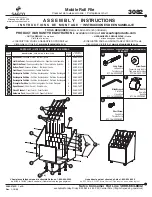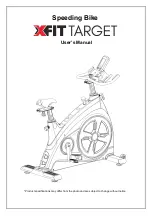
Rev. 7/14/2016
PMPS, MANUAL
Copyright 2016 Vestil Manufacturing Corp.
Page 15 of 22
Operation Instructions (Manual Units):
This pallet handler features an auto-shifting, two-speed pump, which means that pump speed is automatically
selected based on the output pressure of the hydraulic system. For example, when the forks are unloaded, pressure in
the hydraulic system is low and the pump operates in high speed mode. Each stroke of the foot pedal pumps
approximately 1.2 cubic inches of oil. When weight is applied to the table, system pressure increases. At pressures in
the range of 800-1000 psi the pump automatically shifts into low speed mode. In low speed mode, less effort is required
to move the pedal because each stroke pumps just ~ 0.44 cubic inches of oil.
The forks rise with each stroke of the foot pedal. However, if too much weight is applied, i.e. weight exceeding the
capacity, a pressure relief valve opens and allows oil to flow back to the hydraulic reservoir rather than to the cylinder.
As a result, the forks will not rise until the weight of the load is either equal to or less than the capacity (4,000 pounds).
To lower the forks, press the release pedal (see item no. 25 on p. 12). A pressure compensated flow control valve
ensures that the fork carriage lowers at a uniform and controlled rate. Never increase the pressure relief setting more
than necessary. Never exceed the pressure rating of the components in the hydraulic system.
PUMP PURGING PROCEDURE:
Air will periodically become trapped inside the pump and will have to be removed. When air is present in the
hydraulic system, you might notice a spongy feel to the foot pedal while pressing it. To remove air from the system:
1. Completely lower the forks and unload them.
2. Remove the fill plug from the oil reservoir.
3. Disconnect the hydraulic hose from the port on the cylinder and insert the free end of the hose into the fill port of the
reservoir;
4. Pump the foot pedal several times and pay close attention to the stream of oil flowing into the reservoir. Pockets of
air will escape as oil flows into the reservoir.
5. Once air is completely removed, reconnect the pump to the cylinder by reattaching the hydraulic hose to the cylinder
port.
6. Check all of the hydraulic lines for oil leaks.
7. Although air has been removed from the pump, air could still be trapped in the cylinder. The next procedure explains
how to remove air from the cylinder.
CYLINDER PURGING PROCEDURE:
A bleeder screw is located at the top of the cylinder. The bleed screw includes a hose fitting to allow attachment of a
small diameter hose. By attaching a hose to the screw, any oil that escapes during the bleeding process can be directed
into a container for proper disposal. To bleed air from the cylinder:
1. Completely lower the forks and unload them.
2. Gently pump the foot pedal once;
3. Carefully open the bleed screw. The pressure built in the system from pumping the pedal causes air (and oil) to flow
out of the bleed screw. Pressure will drop as air and oil flow from the cylinder. To pressurize the system, close the
bleed screw and pump the pedal once. Open the bleed screw again to allow more trapped air to escape;
4. Repeat step 3 until air is completely removed from the cylinder (only oil flows from the bleed screw);
5. Check all of the hydraulic lines for oil leaks; then return the table to service.








































